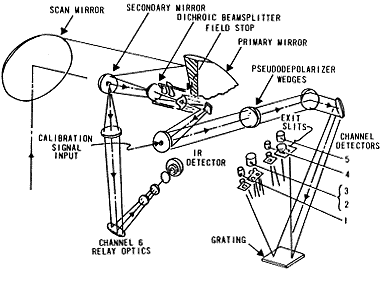CZCS was one of eight instruments flown on the Nimbus-7 spacecraft, which was launched on October 24th, 1978. The spacecraft was in a Sun-synchronous orbit, with an inclination of 104.9 degrees, and a nominal altitude of 955 km. It had an equatorial crossing time of noon, in an ascending orbit.
The CZCS was a cross-track scanning system using a conventional multi-channel scanning radiometer with a rotating plane mirror at a 45 degree angle to the optic axis of a Cassegrain telescope. The rotating mirror scanned 360 degrees; however, only data centered plus or minus 40 degrees of the spacecraft nadir were collected for ocean color measurements. The Instrument Field of View (IFOV) of each detector was 0.865 mrad, yielding a resolution of 825 m at the satellite subpoint (i.e. nadir view). The swath covered 1566 km in width. Data were then transmitted to a receiving station at a rate of 800 kbps, at a digital resolution of 8-bits.
The table below shows the minimum signal-to-noise ratio specified for the instrument at its most sensitive gain setting.
| Band | Wavelength \((nm)\) | SNR | Radiance \((mW/cm^2/nm/ster)\) |
|---|---|---|---|
| 1 | 443 | 150 | 5.41 |
| 2 | 520 | 140 | 3.50 |
| 3 | 550 | 125 | 2.86 |
| 4 | 670 | 100 | 1.34 |
| 5 | 750 | 100 | 10.8 |
| Band | Wavelength \((nm)\) | NEδT \((K)\) | Brightness Temperature \((K)\) |
| 6 | 1150 | 0.220 | 270 |
| This line diagram illustrates the optical method by which discrimination of the spectral bands was achieved. The incoming beam was first split by a dichroic beam splitter, one portion of the beam going through a set of depolarizing wedges to a small polychromator where the radiance was dispersed and detected by five silicon diode detectors in the focal plane of the polychromator. Radiance in the 10.5 to 12.5 micron spectral band was reflected off the dichroic and then imaged onto an infrared detector of mercury cadmium telluride cooled to approximately 120 degrees Kelvin using a radiative cooler. See images of the instrument here. |  |
As can be seen in the above optical schematic, the instrument was equipped with a depolarization apparatus (denoted 'pseudodepolarizer wedges' in the above figure). A piece-part depolarization scrambler test indicated a 0.5% sensitivity to monochromatic light (wavelength not provided). However, a system-level test showed that the instrument exhibited a polarization sensitivity upwards of 3% at +/-10 degrees tilt (the instrument manufacturer did not report sensitivity above 10 degrees), with the highest sensitivity at the 443nm band. No information was provided on polarization phase function. The validity of the system-level test is uncertain due to problems with test setup.
Since NIMBUS 7 flew in an ascending orbit (i.e. from south to north in daylight), the CZCS scan mirror was positioned to aft of the satellite when the spacecraft was south of the subpolar point and forward of the spacecraft when it was north of the subpolar point. The instrument was capable of adjusting the tilt in 2 degree increments from 20 degrees aft to 20 degrees forward.
The radiometric sensitivity of the first four bands was adjustable. Each of these bands have four separate gains that change, on command, to accommodate the range of sun angles observed during a complete orbit and throughout the various seasons. The gains are changed to utilize the best dynamic range possible without saturating over water targets. Normally, the gain used in the first four channels is determined by the solar elevation angle of the target to be acquired. Most of the imagery was acquired at the two higher gain settings (gains 1 and 2)
Tilt and gain setting information were transmitted with the CZCS data and are included in the data product metadata records.
The infrared temperature sensor (channel 6, 10.5-12.5 microns) never functioned satisfactorily, and was useful only in the first year (1979) in a relative sense.
The detector lost sensitivity rapidly above its operation temperature, and eventually saturated only a few degrees above its operation point. The date ranges given above indicate when the detector was within the range 119.1 to 121.1 K. The reasons for the failure were never determined with any degree of confidence. Three potential reasons were:
Subsequent to August 1982, all attempts to restore some useful operation to the thermal channel were discontinued.